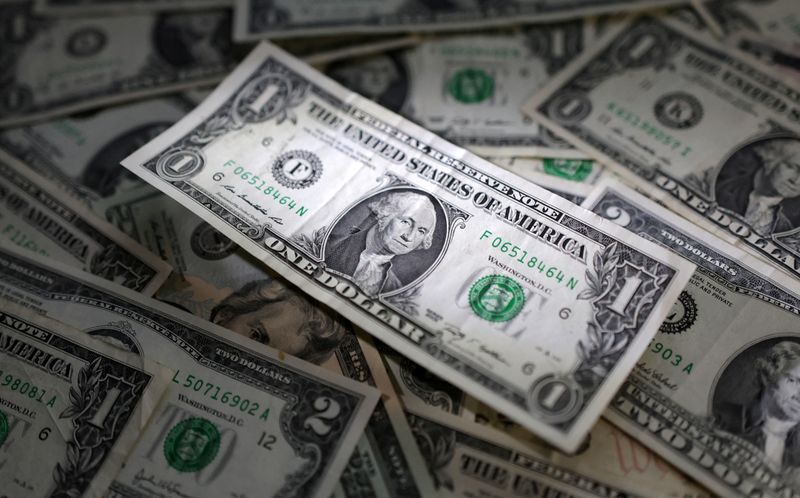Dollar slides on sluggish US data, Aussie steadies ahead of RBA
2023.04.03 22:17

© Reuters. U.S. dollar banknotes are seen in this illustration taken March 10, 2023. REUTERS/Dado Ruvic/Illustration
By Rae Wee
SINGAPORE (Reuters) – The dollar wobbled on Tuesday after a slump in U.S. manufacturing activity last month pointed to further signs of a slowing economy and trumped renewed inflation concerns following OPEC+’s surprise output cut.
The Institute for Supply Management (ISM) survey showed on Monday that manufacturing activity fell to the lowest level in nearly three years in March as new orders continued to contract, with all subcomponents of its manufacturing PMI below the 50 threshold for the first time since 2009.
That sent the greenback broadly lower, tracking a slide in U.S. Treasury yields, as investors pared expectations on how much longer interest rates would need to remain in restrictive territory.
Against the sliding dollar, the British pound and the Australian and New Zealand dollars rose to multi-week highs in early Asia trade on Tuesday.
Sterling peaked at its highest since late January at $1.2425, extending the previous session’s 0.7% gain.
The rose 0.2% to $0.6310, its highest since mid-February, while the was marginally lower at 102.02, having fallen more than 0.5% on Monday.
“The ISM manufacturing report for March was a dud,” said economists at Wells Fargo (NYSE:). “The closest thing we get to good news in (the) report is that the slowing in the factory sector is pushing prices lower and supply chains are continuing to heal, benefiting from the slack.
“Beyond that, the rest of the themes were those that often precede an economic recession.”
The euro was last 0.03% higher at $1.0905, having gained more than 0.5% on Monday. Against the Japanese yen, the dollar slipped 0.09% to 132.35.
Futures pricing show that markets expect the Federal Reserve to begin cutting rates as early as September through the end of the year, with rates seen just above 4.3% by December.
The two-year Treasury yield, which typically moves in step with interest rate expectations, was last at 3.9841%, having fallen nearly 10 basis points on Monday. [US/]
The sluggish U.S. economic data overshadowed renewed inflation fears after the OPEC+ group jolted markets with plans to cut more production, a move which sent oil benchmarks jumping 6% on Monday.
“Apart from the direct cost impact of the 6-7% jump in oil prices, economic headwinds are also posed by the prospects of stickier inflation prolonging the global tightening cycle (and) intensifying policy trade-offs,” said Vishnu Varathan, head of economics and strategy at Mizuho Bank.
Elsewhere, the steadied after rising to a more than one-month high of $0.67935 earlier in the session, ahead of a key monetary policy decision by the Reserve Bank of Australia (RBA) later on Tuesday.
The RBA will pause policy tightening according to a poll of analysts, although a strong minority still forecast a hike.
Data out last week showed Australian inflation slowed to an eight-month low in February, due in part to a sharp retreat in prices for holiday travel and accommodation.








